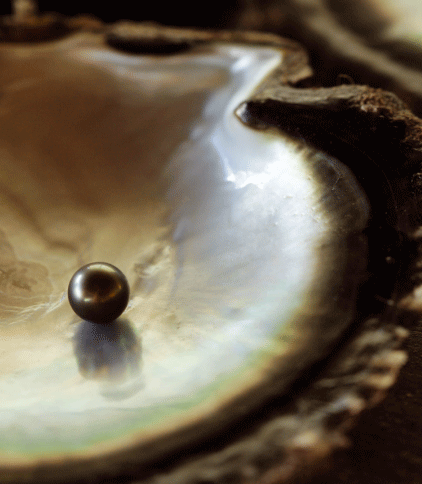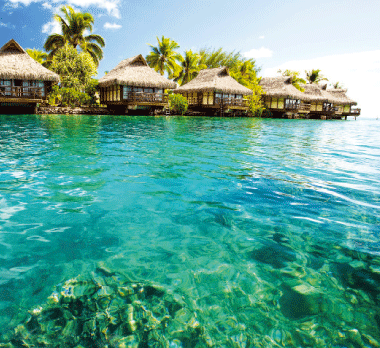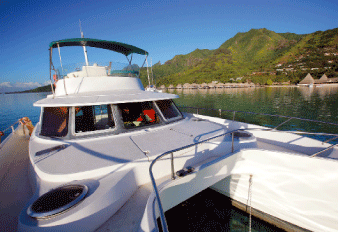
French Polynesia
In Search of the Black Pearl
 |
It's late afternoon, and I'm standing at the end of a long dock jutting out over the glistening South Pacific.
I check my snorkel and mask, cinch my fms one last time, and leap into the turquoise water with only one thing on my mind: I want to find a black pearl. I can hear my breath, steady and deep, through my snorkel as I swim out past the parrot fish to where the water deepens into a richer blue.
By Andrew Mc Carthy Photos Aaron Huey
I remind myself that the hammerhead and blacktip sharks that patrol this lagoon at sunset won't arrive for a few hours yet, by which time I should be back on land. Shafts of sunlight cut deep. Suddenly I see them, hundreds of encrusted oyster shells secured to a rope stretching from an anchor on the sea bottom to buoys floating on the surface. At last! These gnarly looking shells house some of the ocean's fmest treasures. I dive, but I haven't taken enough air. Fearing that my prize will be lost if I retreat for even a moment, I go deeper. Pressure screams in my ears. I clutch the algae-covered rope and grab for a shell. Will it hold the pearl I came to find?
This quest for the black pearl began in New York City. My mother, with a big birthday coming up, had coyly told me, "Years ago, I saw a single black pearl hanging from a simple chain. I've never forgotten it." That was all I needed to hear. I spent the next uninspiring day traipsing from one jewelry shop to the next, finding only a few (pricey) black pearls. Then I asked a jeweler a simple question: "Where do these come from?"
"Tahiti."
My mind swam with images of white sand and cool breezes.
Instantly, I hatched a plan. I would pluck my motller's gift from the sea, personally, still soaking wet.
So I have come to French Polynesia, a loose collection of 118 islands _Tahiti being the most populous with 275,000 people – splattered over an area nearly the size of Europe and situated roughly halfway between South America and Australia. This is the epicenter of tlle black pearl universe.
Ever since 1768, when word filtered back to Paris from navigator Louis-Antoine de Bougainville the islands of Tahiti.
But I am here – on the island of Moorea, a nine-mile catamaran ride from Tahiti itself – on family business. And it's apparent that the first thing I need is guidance, because to my untrained eye all the small, dark pellets displayed at Ron Hall's unpretentious lagoon-side shop look the same.
"The pearls sell themselves; I just educate," Hall explains, his blue eyes locked on mine as he leads me through his "Fifteenminute Pearl School."
Moorea, one of the Society Islands, the most visited of the five archipelagos that comprise French Polynesia, is shaped like a south-pointing triangle cut by two deep bays on its northern side. With a mountainous, nearly impenetrable interior, white sand beaches, and famous blue lagoon defined by an offshore coral reef, the island is often seen in video footage depicting the ultimate South Seas paradise-and that's exactly what it is. Hall, a gregarious American who greets patrons in "John Wayne French" that he learned locally, has found his spot – a well-chosen perch at the eastern entrance to Cook's Bay. He first came here in 1974, arriving from Hawaii to crew on actor Peter Fonda's yacht, and then stayed.
Hall married a local woman, a traditional Tahitian dancer (whose likeness was embossed on a local postage stamp), raised two kids in his bayside paradise, and continues living the dream. "It's the way I wanted Hawaii ro be," he says of Moorea. But even a cursory glance at its underdeveloped shoreline draws a stark contrast to modern Hawaii, with its strip malls and condominium complexes. What's more, Moorea hosts only 124,000 visitors annually – 60 days' worth of tourists in Hawaii.
Hall informs me that Tahitian "black" pearls come in various shades from silver to peacock ro midnight black. Showing examples of different pearls from his collection, he bombards me with facts and statistics, hisrory and hints on what to look for when selecting the perfect specimen.
"But really, it's all about the way the pearl reflects light. Pay attention!" he chides me when he sees my eyes glazing over at all the information, reflecting light of their own. "You don't want to fail pearl school."
He thrusts a particularly radiant pellet at me. "Take this outside and have a look in the sun."
(Try that at Tiffany.) When I do,
the little black beauty shimmers like a mirror.
So rare in the rest of the world, the black pearl is everywhere in these islands. More than two dozen vendors sell them on Moorea alone.
(By contrast, I see barely a handful of places to buy a quart of milk.) And while Ron has cornered the laid-back segment of the market, other shops are upscale. A few miles farther on, past Opunohu Bay, Tahia Collins, a Moorea native and former Miss Moorea who speaks with a delicate accent, proudly "sells romance" to the cruise ship crowd from her posh shop on the leeward side of the island. And over on the far slope of Moua Puta, the island's trademark "shark's tooth" mountain that stars on local coins and countless postcards, Dominique Seybald, a slender, dark-haired transplant from France, sells pearls out of her home. When I visit, she extracts several large plastic bags fuled with hundreds of loose dark pearls from behind thc living room sofa and hauls them onto the front porch for viewing.
"I like them black, the blacker the better," she confides, to which the long strand around her neck attests. And around the southern tip of the island, her son Pierrick offers pearls knorred into leather straps for the surfer set – "Quick Perles," his roadside banner boasts.
But all this shopping, circling Moorea's 37-mile ring road, constantly tempted by views of the aqua blue lagoon, is finally too much to bear. So next morning I'm tearing across the water with Michael Poole in his 34-foot, open-hulled speedboat. Poole is founder and head of the Marine Mammal Research Program on Moorea. A "full-time scientist, part time ecotour operator" who landed on the islands in 1987, he's an eager, brown-haired Air Force brat who dreamed of moving to Tahiti since age 15. He's been running dolphin- and whale-watching tours ro help finance his research since 1992. His passion is infectious.
Poole is a born teacher (he's supervising three doctoral candidates at present), never content to simply lecture, preferring the Socratic method of posing leading questions. When we come upon a group of more than 50 Gray's spinner dolphins that begin to leap out of the water and surf the bow wave of our boat, he starts in:
"Why will you find the dolphins near the mouth of a pass, with easy access to the shallow water of the lagoon?" (Answer: protection from sharks.)
"Why do dolphins leap?" (For speed and to dislodge parasitcs, among other reasons.) Poole constantly interrupts his own discourse at the sight of breaching dolphins. "There's a triple spin from a young female at three o'clock!" he exclaims, pointing to a spinner dolphin twirling up from the water. "Double tail slap from a mature male at nine o'clock," Poole shouts.
"Wdo they do that?" I ask.
"Can't answer that – need context. Why do you scratch your head?"
"Uh ..."
"Quadruple spin from a young male at one o'clock!"
Eventually the dolphins move on, we glide back across the lagoon, and my eye is drawn to Mount Rotui, crumbling dovm to Cook's Bay on one side and to the even more tranquil Opunohu Bay on the other. Unlike the swollen conicals of Hawaii, tlle volcanoes that created the Tahitian islands have spent themselves utterly. What remains are boney, jagged cliffs with plunging drop-offs framed by the hard blue sky. We pass local men fishing from an outrigger canoe. "The nicest thing about Moorea – there's still authentic culture here,` Poole says.
Indeed, the longer I'm on Moorea, the more examples I find of a thriving Polynesian culture (colored by French colonization). I see an old fisherman with deeply creased skin hanging his catch from a hook at his roadside stand; I see an impossibly beautiful woman crossing the street, her beauty the kind that inspires mutiny (just ask the sailors who landed here aboard the H.M.S. Bounty). And always people are stopping to greet one another, shaking hands, conversations often moving unconsciously between French and Tahitian, seemingly everyone adorned with at least one tattoo (a word derived from the Tahitian tatau). Even at the traditional dance show at the Club Bali Hai, the performers seem to be dancing more for each other than for the tourists, glances and secret smiles exchanged. I yearn to linger – but I've got a date with a pearl farmer.
I met Cyrus Rosenthal over the phone, by mistake. I was trying to call a hotel but dialed Rosenthal's home instead. After I apologized, we chatted. Rosenthal, I leanled, owns and runs one of the oldest pearl farms in French Polynesia. I told him of my quest, and he invited me to tour his operation on tlle atoll of Manihi in the Tuamotu Archipelago. Concluding that fate has intervened on my mother's behalf, I hop a plane.
The Tuamotus – a collection of some 76 wispy atolls, small necklaces of islets encircling crystal-clear lagoons – are an hour's flight to the northeast of Moorea. And while the Society Islands are mountainous, the remote Tuamotus never rise more than three feet above sea level, consisting mostly of white sand beaches and palm trees.
Rosenmal's farm, accessible only by boat, lies in the middle of Manihi's lagoon. Here, in a warren of buildings linked by a series of wooden planks built on stilts, Rosenthal has been producing pearls since 1968. This rangy, deeply tanned man with wild blond hair is in a constant state of efficient movement – gently wedging open the "relaxed" oysters, prepping them for the grafter (who with surgical precision inserts a small mother of pearl pellet around which the pearl will form); making coffee for his workers; sifting through rejected oysters; and, finally, piloting the 27-foot outboard that takes us deep into the lagoon ("my bank,` Rosenthal calls it), where some of the more than 65,000 oysters he is tending must be hauled out for their semimonthly cleaning.
As workers hoist pouches full of oysters on deck, the boat starts to list perilously. Rosentllal, perched in the stem, legs folded Indian style, laughs and calls out orders while effortlessly feathering the throttle to keep the boat steady in the rolling water. With his piercing eyes, he reminds me of a wet, French Lawrence of Arabia. The men continue their haul, the boat sitting loeer and lower. I marvel at the backbreaking work. Rosenthal seems to read my mind. "You think the pearls just get around your neck by miracle?" he shouts through the trade winds.
Later, back at the farm, during a lunch of lentils, baguette and imported pate in Rosenthal's overwater office, it dawns on me that I've seen thousands of pearls and learned a lot about the work of culturing them, but I'm not much closer to fmding a pearl for my mother's big day. I ask Rosenthal if he sells pearls directly to retail customers like me. "No," he says, "but I know some pearl farmers on Fakarava who do.'
Occasionally when you travel, you arrive someplace for the first time and feel instantly more at home than in your own hometown. It happened on my first trip to Ireland, where I have ancestral roots, and it happened when I arrived in Fakarava. Nothing on this atoll just a short hop from Manihi – not its crushed coral lanes or groves of swaying palms – remotely recalls my New Jersey upbringing. Yet I feel at ease here and free to be myself. The locals, mostly Polynesians, welcome an obvious stranger with a curious glance and a nod. The day unfolds with an easy certitude. Heavy downpours materialize and are gone in minutes, burned back by the sun. The night, lit by a riotous Milky Way, is filled with the sound of to'ere drums, at first ominous and then reassuring, several groups in different locations calling and answering, the rhythms carried across the lagoon.
Dawn finds me pedaling a bicycle left at my guest house into one of the atoll's villages, Rotoava, a loose collection of homes with even the most humble sporting satellite dishes. I swerve to avoid uncollared dogs, scurrying crabs, coconuts that lie where they fell, and massive snails crossing the only paved road on the island.
Then I notice a simple white build.ing, smoke pouring from its aluminum chimney, people coming and going by truck scooter, bicycle, and on foot. Colonialism may have its drawbacks, but one advantage is being able to get a piping-hot, moist, pain au chocolat 9,700 miles from Paris and then sitting on a wall in front of the local church to watch the sun rise over the Pacific less than 100 yards in front of me, the crystal lagoon a few yards to my back. (Indeed, I'm on a really narrow tongue ofland.)
But I've got work to do. I've come to see Joachim Dariel, a Frenchman with a romantic sensibility who opened his own small-scale pearl farm in 1990. He's agreed to not only let me shop for pearls at his farm but also to arrange a dive so I can harvest my own from the sea.
That explains how i've come to be clutching at oysters deep in a shark-infested lagoon, my lungs feeling as if they are about to explode, my ears ready to burst.
Safely back on the dock, frees the oyster I grabbed from the rope and pries it open. I can see a lump through the fleshy tissue. Mateata makes a small incision, and there it is, a fairly good size, oval, blue-gray pearl. He tilts the shell, and tlle treasure drops into my palm. I grin like an idiot. It may not be the most beautiful pearl I've ever seen; it doesn't exactly shimmer like the midnight sun – but it's mine. I wouldn't trade it.
Later, rolling my mother's gift between my fmgers, I sit on the same wall I sit on each morning, except now I'm facing the other direction, toward the lagoon; it's a deep purple, holding the last of the fading light, the Pacillc already a dark mass behind me, the Southern Cross beginning to assert itself in the sky. The drumming will begin soon. I've often threatened to run off, to simply disappear. If I ever do, I've got my eye on a grove of palms that border a lagoon on one side and an ocean on the other.
But first, there's a birthday party to
attend.